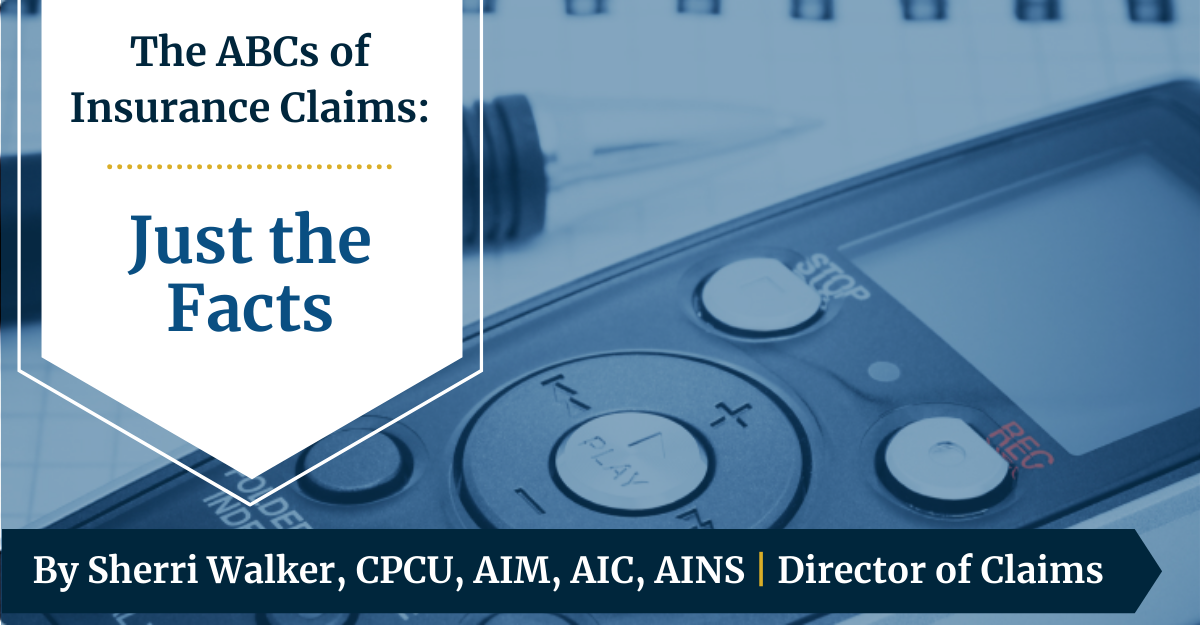Welcome to the ABCs of Insurance Claims. Over the next few months, Sherri Walker, Sentinel’s Director of Claims will address an aspect of claims handling for every letter of the alphabet to help provide a better understanding of the claims process.
Recorded Statements for Filed Claims
Experiencing an accident or loss can be extremely overwhelming and elicit a range of emotions – including fear, anger, sadness, and stress just to name a few. Those feelings can continue throughout the aftermath, especially during the claims adjustment process. Dealing with a claim can feel like being caught in a maze but knowing what to expect can empower you to take control of those emotions. Providing just the facts is important in the process regarding recorded statements.
It is very likely that you will be asked to provide a recorded statement when a claim is filed. It is a standard part of the investigation process and provides the adjuster a detailed version of what happened in your own words. When the adjuster requests a statement, they will typically have a recorder attached to the phone and take the statement right then and there. In addition, there are times they may ask to meet with you in person to secure your statement. There can be multiple reasons for this, and it may be just as simple as the adjuster’s personal preference and should not be a cause for alarm.
Most statements are comprised of four parts: Introduction, Standard Questions, Narrative and Closing. The specifics may vary from adjuster to adjuster and carrier to carrier, and the types of dialogue may change depending on the nature of the claim involved, but they are all important to securing a thorough description of the fact pattern.
Part I: Introduction
The first segment of a recorded statement is the Introduction. This portion is usually scripted and will address the date and time of the recording, introduce each person who will be speaking or present on the recording, and if the recording is in person will often detail the location that the statement is being recorded. This may also include a request to validate the age/date of birth of the parties speaking, as well as confirming a home address or other contact information.
This segment will usually include consent questions such as “Are you aware that I am recording our conversation?” and “Do I have your permission to do so?.” Laws vary from state to state as to who must provide consent for recording, but even in one party consent states, this is normally asked in the event that the statement should be used as a matter of record for litigation.
Part II: Standard Questions
The second portion of the statement is typically a set of standard questions that may be material to the facts of the loss. For example, if the statement is regarding an automobile accident it may include information regarding who was driving, if they have a valid driver’s license, what roadway the accident occurred on as well as the demographics of that roadway – such as number of lanes, type of intersection and traffic controls, and whether the roadway is straight, curved or hilly. There will likely be questions regarding what the weather or lighting conditions were at the time, and how heavy the flow of traffic was. There may also be questions regarding the number of passengers, and whether seat belts were being used.
In other types of claims, these questions will be related to the exposures at hand – in a homeowners claim such as a fire, theft, or severe water loss, they may include questions regarding ownership, residents including pets, the age of the home or any recent/prior work or additions to the home, as well as who was at the property when the loss occurred. In slip and fall claims, the questions may regard what type of flooring or surface the fall occurred, the fall victim’s purpose for being there, any types of markings or railways that are present, and how familiar the fall victim is with the area.
Part III: Your Narrative
The third portion of the statement is when the adjuster opens the floor and says, “Tell me what happened.” This is without a doubt, the most important stage, but also the most potentially perilous portion of the statement. This is where the title of our blog today comes from – it is important to provide “just the facts.” Now is the moment to be concise and clear about what happened, but to also be mindful that this is a recorded statement of your version of the facts.
It is important to make sure that you are not embellishing, not becoming overly emotional, and not guessing at answers. Injecting personal speculation into your narrative during this recording can make it harder for your adjuster to understand exactly what occurred, or to defend you should the need arise. Should the statement have to be transcribed for arbitration, you don’t want to have anything in ink that you wish wasn’t there. As my grandmother would advise, it’s better to say it and forget it than to write it and regret it.
During this portion of the statement, it is easy to fall into the trap of continuing to speak to fill the silence that the adjuster is giving you to tell your side of the story. While it’s important to give the relevant details and information, this is a time that less is more. Keep the narrative concise and focus on providing only relative information. The adjuster may then ask you some follow up questions based on the information you have provided during your narrative, so don’t be concerned if this portion of the statement lasts longer than the others.
Part IV: Closing
The last segment of the statement is the closing, and once you’ve gotten to this point you can take a deep breath – you’re almost finished! This will again typically be scripted. During this closing, the adjuster will ask if you have any additional information you would like to add, and likely confirm again that you are aware that the conversation has been recorded with your consent. They may ask you if your answers are truthful and correct to the best of your knowledge, and then they will again indicate who is speaking and the time and date of the end of the recording.
Best Practices & Tips
There are a few other things that you should know, especially if the recording is done by phone. If you are in a location with background noise, that noise is likely going to be caught on the recorder. I’ve had to re-take statements because of a TV show in the background on high volume. Unless Dr. Phil was in the passenger seat, he likely cannot add anything of value to your statement. Secondly, anyone else who can be heard on the statement or is adding anything to the conversation will need to be identified on the recording as well, so if you have family present that is likely to interject, you should let your adjuster know that is a possibility.
Additionally, once the recorder is going, it will need to continue running, so if you place your adjuster on hold to answer any other incoming calls, the tape will continue to run in your absence, so be mindful of any interruptions. In that same interest, if you do have a call “beep in” while you’re giving your statement, those beeps will likely cut out a portion of what is being said, and you’ll want to pause until the beeping is done and repeat anything that may have been cut off.
We hope that you’re never involved in a loss that requires a recorded statement, but if you are in a position to provide one, we want you to be prepared. Knowing what to expect can help combat the fear of the unknown that tends to come with the claims process. Sentinel‘s knowledgeable team is here to make handling your insurance needs as easy as “ABC.” Please reach out to our team of professionals at Sentinel to learn how to further Safeguard your Success.


